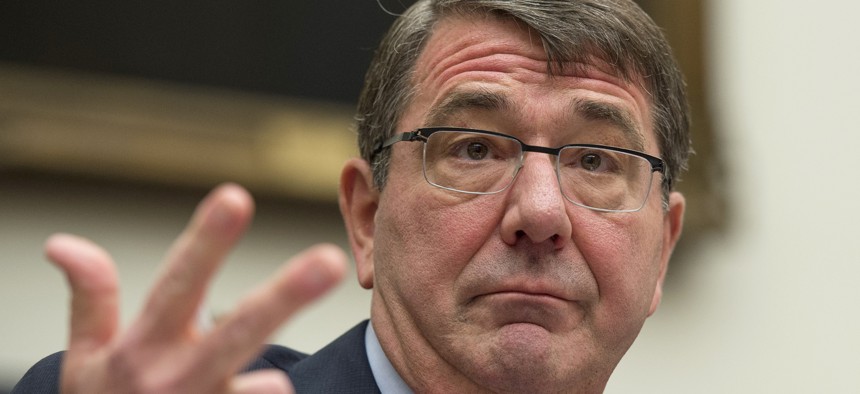
Defense Ash Carter testifies on Capitol Hill in Washington, Wednesday, March 18, 2015, before the House Armed Services Committee . AP
New Pentagon Chief Carter to Court Silicon Valley
The Pentagon wants to partner more with Silicon Valley tech firms, but can radically different cultures find common ground?
The Pentagon desperately wants to be more agile and flexible, but decades of cultural bureaucracy often prevent the nation’s largest organization from being that. Now, a tech-savvy physicist is in charge of the military and he is about to ask companies like Google and Facebook for solutions.
Next week, Ashton Carter will become the first sitting defense secretary in nearly 20 years to visit California’s Silicon Valley. It’s a culture the Pentagon needs to understand better, says Frank Kendall, the Pentagon’s acquisition chief and Carter’s point man for setting up discussions with tech firms.
In a speech at Stanford University next Thursday, Carter will discuss the “future of technology, innovation, and cybersecurity” and meet with industry executives, the secretary said Thursday at the Pentagon. A senior defense official told Defense One that Carter also will “talk about the importance of those relationships, particularly in light of the frustrations that have resulted from things like Snowden.” Going to Silicon Valley is one of Carter’s “highest priorities in his first 100 days of office,” the official said. The Pentagon is billing Carter’s speech, the Drell Lecture at Stanford, as a “major address.” It is titled, “Rewiring the Pentagon: Charting a New Path on Innovation and Cybersecurity.”
For many in the tech community, former NSA contractor Edward Snowden’s 2013 revelations soured their perception of the national security community. Snowden’s disclosures revealed efforts by the NSA to undermine security standards and practices that companies like Google and Facebook put in place to protect the data of customers using their services.
When asked if he would ever consider working for the Defense Department, one Facebook employee told Defense One. “I wouldn't do it personally because the Snowden incident dented my trust and I don't think I'd be a good fit there.”
Those disclosures have also cost the technology industry a lot of money. Last year, the Information Technology and Innovation Foundation, or ITIF, calculated that the NSA scandal could cost the industry as much as $35 billion in three years. The loss comes from foreign customers taking business elsewhere or new proposed or enacted legislation in numerous countries demanding that companies like Google hold user data in the country where the user is located. Last week, Google announced it would move some of its servers to Russia to appease officials at Russia’s state-controlled telecommunications company and comply with that country’s new laws.
“If your business depends on storing and securing large amounts of customer data (i.e., what they call in the Valley ‘B to C’ or ‘business to consumer’ applications, i.e., the Googles and Facebooks of the world, as well as a host of smaller players in this market), then Snowden is still a very big deal,” Jason Tama, a fellow at the Brookings Institution, told Defense One. “Many of these companies see any association with defense, national security, and the intelligence community, in the same way Superman sees kryptonite, as an existential threat. When your business model depends on customers trusting your solution, your cloud, and your security, anything that might erode that trust is a very big deal. Right now these companies still perceive any association with the national security enterprise as a fundamental threat to sustaining customer trust. In these markets the cost of eroding customer trust far outweighs any possible benefit from defense/national security business.”
The trust gap may be wide but it’s not the biggest barrier to the Pentagon making new business inroads into the valley, according to Tama’s research, which is based on interviewing dozens of members of the technology and national security communities.
Current Defense Department acquisition processes, procedures and requirements make working with the Pentagon too difficult for many of Silicon Valley’s youngest and most nimble players, says Tama. A recent Government Accountability Office report found that the average acquisition time for a weapons program is two years, an eternity on valley time.
“The Pentagon is just a really bad customer for these smaller, faster moving companies, as the system is heavily biased toward larger, traditional contractors. These larger players have the expertise to navigate a very complex and opaque acquisitions system, as well as the resources to wait out the long and highly uncertain sales cycles. This is a fundamental point people need to understand, and it has nothing to do with Snowden or any other ideological red herring that is out there,” said Tama.
The secretary will also discuss how the Pentagon uses cyber technology to defend the United States.
“It is important that the Department of Defense and the innovators in Silicon Valley maintain a strong relationship,” the senior defense official said. “It’s been the bedrock of ingenuity in our country both for defense and commercial applications for decades and it will continue for the future.”
Bill Perry was the last defense secretary to visit Silicon Valley in 1996, defense officials said. Joint Chiefs Chairman Gen. Martin Dempsey visited the area in July of 2012.
Carter spent a year at Stanford as the Payne Distinguished Visitor at the Freeman-Spogli Institute for International Studies at Stanford after he stepped down as deputy defense secretary in late 2013. The Drell Lecture is an annual event named for theoretical physicist and arms control expert Sidney Drell, according to the school’s website.
For the remainder of President Barack Obama’s tenure, there will be “a real big focus on this to try to become more closely aligned with the commercial industry,” Deputy Defense Secretary Robert Work said last month.
“Most of the [technological] advances that are happening ... are really being led by commercial entities,” Work said. “And we have to be able to track that talent.”



